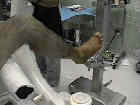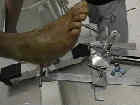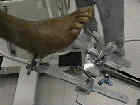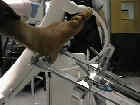- Supine - No Traction:
- easiest method is supine position, w/ several rolled towel/blanket bumps placed side by side which elevates the fractured extremity above the other side (which is necessary inorder to get a lateral view on flouro), and which facilitate knee flexion (which is necessary for entry into the proximal IM canal);
- flourscopic pitfalls:
- flouroscopy will be on the opposite side of the table (non operative side);
- which ever technique of positioning is used, be sure that a good AP and lateral is obtainable before preping the patient;
- ensure that the patient's feet lie at the edge of the table (if the patient is placed too far cephalad, the OR table's central post may block the flouroscan from reaching the proximal tibia (remember that inorder to obtain an AP of the flexed tibia, the flouroscan needs to be tilted towards the central post of the OR table);
- ensure that the cover for the flouroscope is not so short that it comprimises sterility (esp w/ the lateral);
- reduction pitfalls:
- holding reduction will be difficult if fracture is segmental or if it is oblique;
- the surgeon must have some strategy for reducing the fracture before he/she preps;
- consider use of universal large distractor;
- tourniquets:
- tourniquet may aid exposure but must never be used during reaming, as absence of blood flow increases the extent of thermal necrosis;
- tourniquet is also contraindicated if compartment syndrome is likely;
- Supine on Fracture Table - w/ Calcaneal Traction Pin:
- use of fracture table is most indicated w/ segmental fractures in which it may be difficult to hold fracture reduction;
- use of calcaneal traction on a fracture table is associated w/ a higher rate of neurologic injury than is seen w/o traction;
- Alternative Methods:
- be extremely careful of any type of position that places compression across the posterior thigh;
- both the fracture table (posterior thigh bar) and the ACL "triangular thigh bolster" allow allow the hip and knee to be flexed (which is the optimal position for IM nailing);
- both the fracture table and the triangular thigh bolster have caused anecdoctal cases of popliteal artery occlusion







